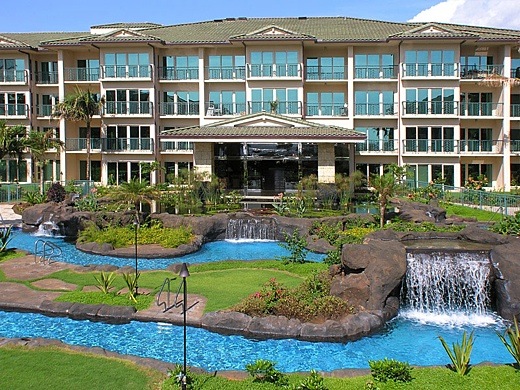 Image above: The hideous Waipouli Beach Resort on the east coast of Kauai.
From (http://www.waipoulibeachcondorentals.com/waipouli_beach_resort_c206)
By Coco Zickos on 21 February 2010 in Carden Island News -
(http://thegardenisland.com/business/local/article_688f75e8-1eb9-11df-aa97-001cc4c002e0.html)
Hotel occupancy continued to slide in December 2009 to some 50 percent on Kaua‘i and averaged about 60 percent for the entire year, according to statistics released by Hospitality Advisors and Smith Travel Research earlier this week.
Image above: The hideous Waipouli Beach Resort on the east coast of Kauai.
From (http://www.waipoulibeachcondorentals.com/waipouli_beach_resort_c206)
By Coco Zickos on 21 February 2010 in Carden Island News -
(http://thegardenisland.com/business/local/article_688f75e8-1eb9-11df-aa97-001cc4c002e0.html)
Hotel occupancy continued to slide in December 2009 to some 50 percent on Kaua‘i and averaged about 60 percent for the entire year, according to statistics released by Hospitality Advisors and Smith Travel Research earlier this week. Calling 2009 a “tumultuous” year for hotels, Hospitality Advisors reported hotel revenues for the 50th state fell by $741 million during the year.
“Although the occupancy rate of 50 percent is alarming, it’s not unusual, especially during the economic environment we’re in,” Office of Economic Development Director George Costa said in an e-mail Friday. November and December typically signify some of the “lowest occupancy periods of the year.”
Kaua‘i has “experienced a cycle of very low and rebounding occupancies” within the past 30 years, including following Hurricane ‘Iwa in 1982 when hotel occupancy rates were also some 50 to 60 percent, Costa said.
This time, however, hotels are reportedly struggling to stay afloat, according to data from Hawai‘i real estate firm Colliers Monroe Friedlander.
Three resorts on island — ResortQuest Kaua‘i Beach at Maka‘iwa (now called Aston Kaua‘i Beach at Maka‘iwa), Aloha Beach Resort and Hilton Kaua‘i Beach Resort (now called Kaua‘i Beach Resort) — are either 60 days or more late on their mortgage payments or the lender has foreclosed upon the property and “taken back title,” said Colliers Monroe Friedlander Vice President and Division Manager Mark Bratton on Friday.
There are others heading in a similar direction, he said.
“It was so easy to borrow money two to three years ago and you could borrow quite a lot,” Bratton said. “Since room rates have gone the other way, they can’t service the debt.”
The situation is “happening more to hotels than any other groups of properties” because they are so reliant upon hotel room rates which fluctuate on a daily basis, he said. “They are all having trouble.”
“Hotels will have difficulty maintaining profitability or breaking even if occupancies remain at 50 to 60 percent or drop lower,” Costa said. “Depending on the owner’s financial reserves and their ability to draw on these, they may be able to stay in business for several years if all other factors remain constant.”
Costa cites a “main area of concern” to be the price of oil which has been steadily rising for more than a year now and settled at around $80 Friday. The prices will affect travel and the cost of doing business, he said.
“That’s why it’s even more important to develop renewable energy projects that will eventually help to lower the cost of electricity and that can be passed on to visitors in the way of affordable vacations, and residents in less to pay for basic services and have more disposable income,” he said.
While occupancy rates have dropped, the average price of a hotel room was actually higher in 2009 than in prior years on Kaua‘i. The average daily rate for 2009 was some $186, while rates for the month of December were around $200, according to Hospitality Advisors and Smith Travel Research. Average daily rates in 2004 were about $177 and $184 in 2005 when the economic tides had not yet turned.
“There’s no question that Kaua‘i is dependent on tourism,” Costa said. “It can be argued what the exact percentage is, but well over 50 percent of our economy either relies on or is affected by the visitor industry.”
The accommodations and food service sector of the industry employs about 24 percent of the Kaua‘i workforce alone, he added.
Economists are currently forecasting a “slow, gradual recovery” that could take at least two to three years, Costa said. If — and only if — there is a quick economic turnaround, “it would mean visitor arrivals would increase” and businesses could start rehiring employees who were laid off during 2008 and 2009, Costa said.
See also: Ea O Ka Aina: Hawaii Hotel Tourism Cratering 1/8/10
.
No comments :
Post a Comment